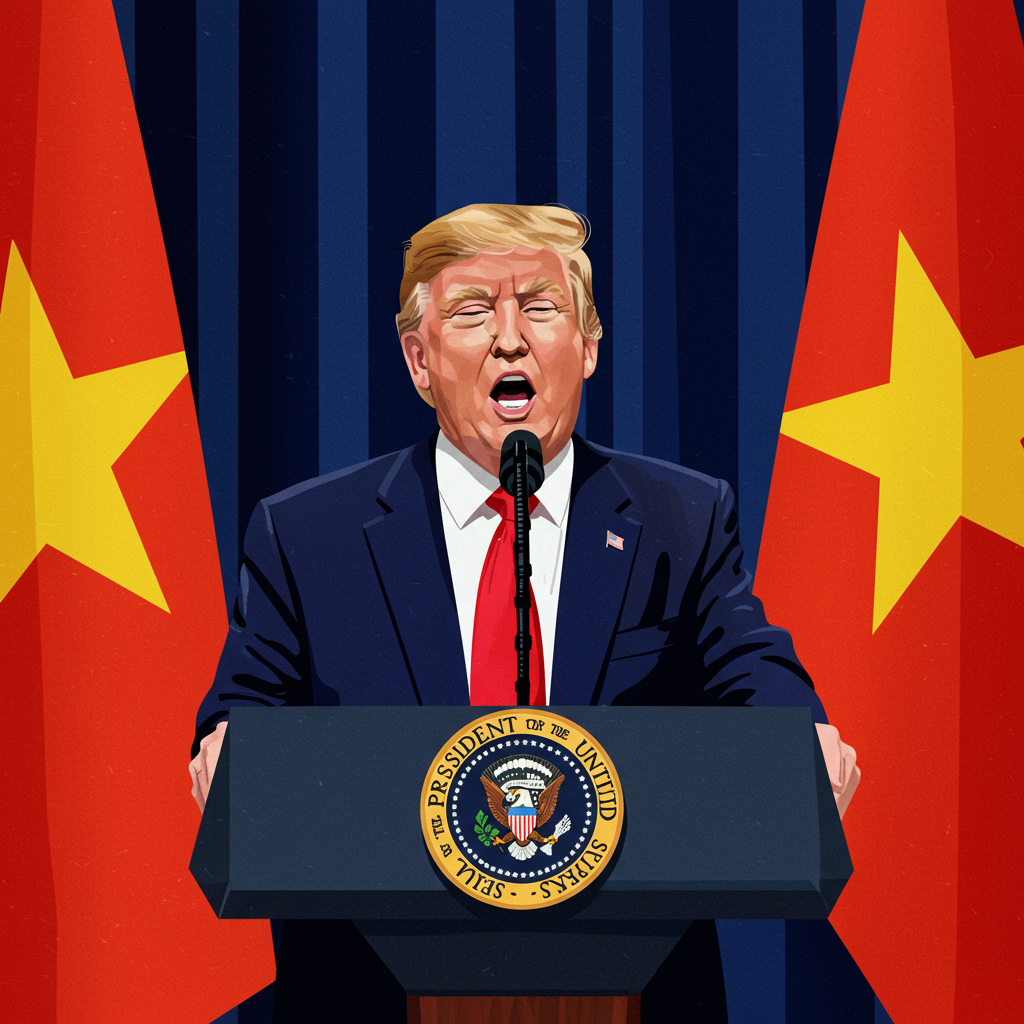Wall Street opened Thursday navigating a complex landscape, balancing aggressive new tariff threats from former President Trump against the enduring momentum of the tech-fueled market rally led by AI giant Nvidia. While the market initially showed a mixed reaction, underlying currents of optimism and skepticism shaped investor sentiment.
Early trading saw the Dow Jones Industrial Average edge lower, shedding 38 points, a modest 0.1% dip. The S&P 500 remained largely unchanged, holding broadly flat. In contrast, the Nasdaq Composite, buoyed by continued strength in technology and artificial intelligence shares, posted a slight gain of 0.2%, building on its fresh record close from the previous day. Both the S&P 500 and Dow remained within striking distance of their own recent all-time highs, reflecting the market’s overall resilience.
Treasury yields saw a slight uptick, with the yield on the 2-year note climbing to 3.87% and the 10-year yield rising to 4.35%. Adding a positive economic data point, initial jobless claims registered below economists’ expectations, coming in at 227,000.
Tariff Threats Resurface Amidst Global Tensions
A significant factor weighing on market sentiment was the re-emergence of President Trump’s tariff rhetoric. Despite signaling potentially steep tariffs against numerous trading partners with an effective date of August 1, Wall Street initially appeared to largely dismiss these threats.
Recent actions included a letter sent to Brazil late Wednesday, specifically threatening a substantial 50% tariff on goods imported from the country. This high rate is notable among recent communications. The justification provided for this measure was linked to legal actions against Brazil’s former President, Jair Bolsonaro, and perceived issues concerning U.S. technology firms operating there. Beyond Brazil, broader tariff crackdowns involving the EU and India were also signaled. Specific proposals included a potential 50% tariff on copper imports, and steep 200% duties on Brazilian pharmaceuticals. Trump also targeted BRICS nations collectively with a proposal for an additional 10% tariff. These threats raise concerns about potential disruptions to global supply chains, increased inflationary pressures, and impacts on commodity markets and industrial sectors, particularly mining and energy.
The AI Rally Charges On, Led by Nvidia
Counterbalancing the trade uncertainty is the powerful, ongoing rally in the tech sector, specifically driven by enthusiasm for Artificial Intelligence. Nvidia (NVDA) continues to be a focal point, with its shares powering higher ahead of the upcoming earnings season. The AI chip leader recently achieved a historic milestone, briefly surpassing a staggering $4 trillion market capitalization, positioning itself as the world’s most valuable public company.
This achievement, alongside robust performance from other tech giants like Microsoft, has significantly propelled the Nasdaq Composite to record highs. The AI boom, concentrating around semiconductor and cloud computing stocks vital for powering AI technologies, maintains strong upward pressure on index values. Nvidia’s stock, in particular, has shown continued strength, reflecting investor confidence in the demand for its AI infrastructure products.
Are Investors Betting on “Trump Always Chickens Out”?
Despite the explicit tariff threats, many on Wall Street seem to be taking a “wait and see” approach, largely ignoring the warnings for now. This market behavior is interpreted by some as a continuation of the “Trump Always Chickens Out” (TACO) trade dynamic.
According to David Rosenberg of Rosenberg Research, the fact that past threats, such as 200% tariffs on pharmaceuticals, haven’t meaningfully impacted European drugmakers suggests investors don’t believe these pledged tariffs will actually be implemented or that the current “letters” carry significant weight. Past instances of tariff delays, such as postponing EU tariff hikes, have previously led to notable market surges, reinforcing the skepticism that these threats will escalate into a full-blown global trade war. As Rosenberg suggests, “So long as TACO is alive, the light is going to be green for the risk-on trade.” Investors continue to lean towards the view that further deferrals are more likely than the onset of a widespread U.S.-led trade conflict, providing support for riskier assets like stocks.
Beyond Tariffs and Tech: Other Market Movers
While the battle between tariff fears and AI optimism dominates headlines, other factors are also influencing market dynamics. The start of earnings season is a key focus, with early reports providing insights into corporate health. Delta Air Lines (DAL), for instance, saw shares surge in premarket trading after reporting upbeat second-quarter earnings and reaffirming its guidance, offering an early positive signal.
Specific stock movements driven by company news or sector trends also occurred. MP Materials (MP) reacted to a Department of Defense deal, while WK Kellogg (KLG) saw movement on buyout reports. Companies linked to commodity markets, such as Freeport-McMoRan (FCX) and Southern Copper (SCCO), were in focus due to discussions around copper tariffs. Other notable movers included Nurix Therapeutics (NRIX) on strong revenue figures, Costco (COST) following sales data, and double-digit gains in AES Corp (AES) and Bloom Energy (BE). In commodities, gold futures rose as some investors sought safety amidst tariff worries, while WTI crude oil saw a slight dip.
Looking ahead, investors are closely monitoring upcoming economic data releases, particularly weekly jobless claims (already noted as lower than expected), which offer clues about the labor market’s health. Commentary from Federal Reserve officials is also anticipated, providing further insight into the potential timing of interest rate adjustments, which remains a key factor for market direction. The Fed’s June meeting minutes indicated a cautious stance on July rate cuts, with many officials preferring to see clearer signs of inflation control, though a September cut remains a possibility eyed by the market.
Navigating a Complex Investment Climate
Ultimately, the market is navigating a delicate balance. The unprecedented momentum of the AI-driven tech rally, spearheaded by Nvidia’s remarkable performance and valuation, provides a strong bullish undercurrent. This optimism, coupled with anticipation for the earnings season to validate corporate strength and potential future rate adjustments, is currently counteracting the unease generated by renewed trade policy risks.
However, the potential for sustained and firm implementation of the proposed tariffs, particularly the high rates threatened against countries like Brazil, could introduce significant turbulence. Sectors sensitive to trade disruptions, commodity markets, and companies with complex international supply chains remain vulnerable. For now, the prevailing sentiment appears to be a cautious optimism, with investors betting that the tariff threats may once again prove to be more bark than bite, allowing the tech rally to continue driving the market forward.
Frequently Asked Questions
What specific trade tariffs did President Trump recently propose and when would they start?
Former President Trump recently proposed several new tariffs. Key threats include a substantial 50% tariff on imports from Brazil, justified partly by legal actions against Brazil’s former President and U.S. tech firms. Other proposals mention a potential 50% tariff on copper imports, 200% duties on Brazilian pharmaceuticals, and an additional 10% tariff on goods from BRICS nations, alongside broader crackdowns on the EU and India. These potential tariffs are currently signaled with an effective date of August 1.
Why aren’t stock markets showing panic about Trump’s new tariff threats?
Markets appear to be largely ignoring the latest tariff threats based on a theory some analysts call the “Trump Always Chickens Out” (TACO) trade. This perspective suggests investors believe the threats lack real teeth and won’t be fully implemented, similar to past instances where threatened tariffs didn’t materialize or were delayed. Underlying bullish sentiment from the AI rally and anticipation of earnings season are also providing resilience, leading to a “wait and see” approach rather than panic selling.
How is Nvidia and the AI trend influencing the current stock market rally?
Nvidia and the broader Artificial Intelligence trend are acting as a powerful engine for the current market rally, particularly boosting the Nasdaq Composite. Nvidia, leading the charge in AI chips, recently reached a $4 trillion market capitalization milestone, becoming the world’s most valuable company. This performance, coupled with strong showings from other AI-related stocks in semiconductors and cloud computing, is driving significant upward pressure on index values, helping to counteract potential negative sentiment from trade uncertainties.



